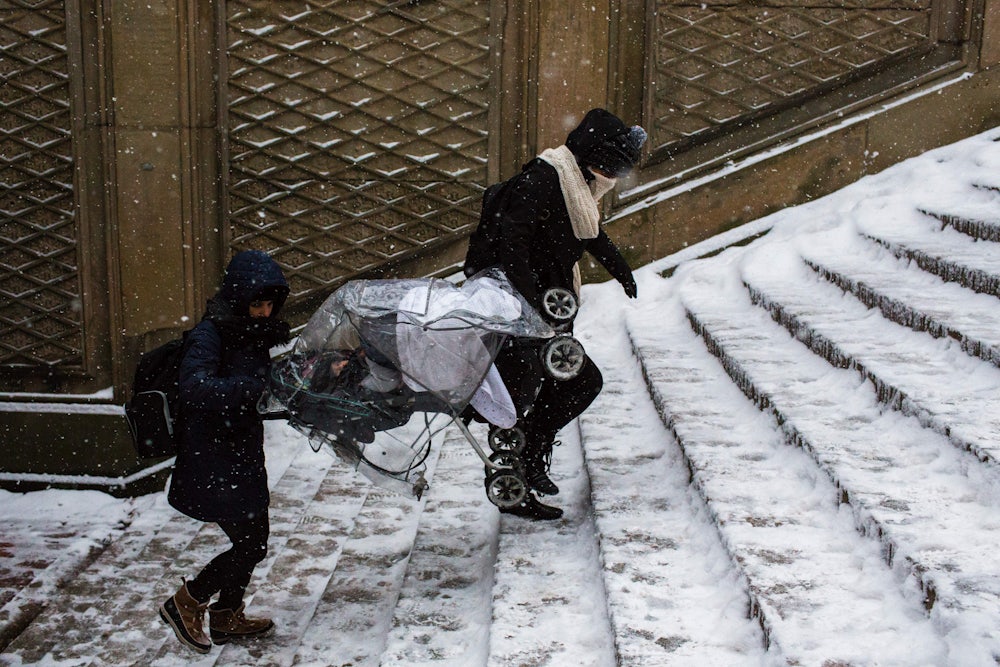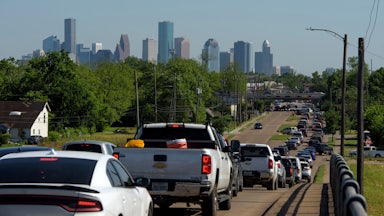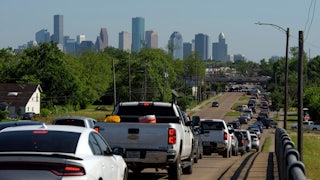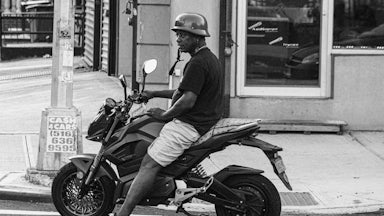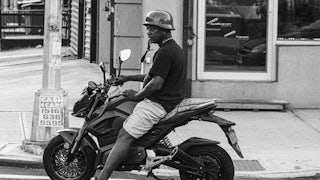There’s an amnesia particular to the experience of parenting babies and toddlers that makes it ill suited for advocacy. No matter how acute the parenting pain of the moment, it never lasts long. Paid parental leave, universal childcare? They have broad public support, and their impact can be felt for decades, even generations. But because parents experience the strain of their absence for only a handful of years, they have never had the same organizing momentum of, say, the student debt movement.
The same goes for navigating U.S. cities with small humans in tow. After a few exhausting years of learning every local sidewalk impassable to strollers; after growing to avoid the many bus systems with rules deterring little kids; after figuring out through trial and error how to carry a child (or two) in a stroller down a steep flight of subway stairs, one day, suddenly, a young child no longer needs to be carried or pushed to get places, and all that hassle and danger and outrage becomes just another thing for the next shift of harried parents to deal with.
What would happen if cities took the lead here? What if transportation planners actively designed for the needs of strollers? Might more people parenting in isolation feel welcomed and find connection outside their homes? Might nannies toting children experience less job stress navigating sidewalks and bus routes that anticipated their needs? Might more affluent families resist the urge to purchase gas-guzzling SUVs, or flee cities altogether, contributing to suburban sprawl and climate change? But this is not just an issue for people with children. Think of the elderly and people pushing carts with their shopping bags; right now, in many cities, if you don’t have a car, hauling groceries by bus is a whole ordeal. And of course, advocates have long struggled to make public transit and city streets work better for people with disabilities. Planning for strollers could lead to transportation systems and whole cities that work better for everyone.*
The Build Back Better bill, along with the bipartisan infrastructure plan that’s now law, offers a chance to find out, and to finally stop leaving caregivers—and many others—stranded on the curb.
Build Back Better, which recently passed the House, allots billions to improving active transportation like walking or biking in poor neighborhoods. With thoughtful planning, this could ease the isolation of families living in transportation deserts with small kids and without cars. Low-income communities of color are often far from transportation hubs, slow to receive sidewalk and road improvements, and the ground zero of pedestrian fatalities. In a recent 10-year period, the rate of Black pedestrians killed by drivers was more than 80 percent higher than that of their white counterparts, according to the Natural Resources Defense Council. For Native American pedestrians, the rates were far higher.
Basic safety upgrades that would benefit all pedestrians, like setting sidewalks farther from the street and adding lighting, crosswalks, and signalized intersections, could make errands with toddlers and strollers safer and less of a hassle. “Daylighting”—which involves removing parking spots near crosswalks to increase visibility—would eliminate the need to poke strollers into streets when determining whether it’s safe to cross. The bipartisan infrastructure bill, meanwhile, earmarks funds for making transit stations more accessible. Stroller-pushers are sure to benefit from functioning elevators; turnstiles wide enough for wheelchairs will work for strollers too.
But it’s no guarantee that accessibility improvements and policies automatically benefit small kids. Many U.S. bus systems continue to ban open strollers, for instance, and not so long ago Boston explored doing the same on its metro. This stands in embarrassing contrast to international cities that actively plan for caregivers. In Montreal, city buses have areas upfront prioritized for both wheelchairs and open strollers.
So far, Los Angeles is the rare U.S. city to take on these issues, albeit largely in an early stage. As in many places, L.A.’s network of rails and buses was designed with the solo, male nine-to-five commuter in mind. A 2019 study showed this isn’t working for women, who make up most of the city’s bus and rail riders and use transit differently. Los Angeles women commonly travel with children while paying for more frequent, shorter trips—often making multiple stops for errands—and tend to travel outside of peak hours, when transit slows. L.A. women are also more likely than men to make no transportation trips at all, something the researchers attributed to the cost, stress, and safety risks of using a transportation system that isn’t designed for them.
“We learned that safety is a huge part of the calculus women have to consider when traveling,” Naria Kiani of Kounkuey Design Initiative, which conducted the study, told the Architect’s Newspaper. “Because they take more trips than men for household and caregiving responsibilities, that fear of safety is multiplied by public transportation systems that do not consider their unique requirements.”
The city is soliciting community input on ideas for improving transit for women, like reducing fares for midday travel, creating more spaces for strollers, and alerting passengers to how crowded the next rail will be. The idea is to create a “Gender Action Plan” to serve as a blueprint for improving transit systems in L.A. and beyond. Los Angeles is already piloting a related project that allows on-demand night bus stops.
All U.S. cities should take note. Treating strollers and caregivers like an afterthought might seem like a benign oversight in transportation planning, but its damage reaches beyond inconvenience and isolation for caregivers and safety hazards for kids. It preserves the long U.S. legacy of withholding government support for families with young children.
Car services rarely have infant seats. It’s illegal in many places to bike with babies. This leaves caregivers without cars dependent on streets and transportation that treat strollers like pedestrians, and caretakers like commuters. That mom on a moving bus struggling to fold a stroller with a baby on her hip? She speaks volumes. So do the parents who’ve resigned themselves to staying home.
*This article has been updated.
